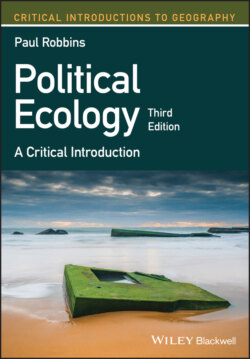Читать книгу Political Ecology - Paul Robbins - Страница 44
Beyond land and water: the boundaries of cultural ecology
ОглавлениеThese limits are perhaps no more clearly seen than in Between Land and Water, Bernard Nietschmann's groundbreaking study of social and ecological change along the Miskito coast of Nicaragua. Nietschmann was a naturalist, but with a strong interest in the workings of culture and a commitment to the scientific study of development problems. In 1968, he departed for a small community of Miskito Indians in the village of Tasbapauni on the Pearl Lagoon on the Caribbean coast of Nicaragua. Equipped with all of the robust tools and theories of cultural ecology, having been trained at the University of Wisconsin by William Denevan, a senior researcher in the field, Nietschmann intended to study subsistence strategy and change along the coast. The study would be extensively quantitative and would involve careful measurement of crops and game, with an eye towards exploring energy inputs and outputs, especially in terms of the harvest of green turtles, which were crucial components of Miskito subsistence and livelihood: classic cultural ecology.
Nietschmann’s extensive and detailed quantitative conclusions are complex. His work concluded that the Miskito depend on hunting and fishing as key supplements to crop subsistence, since they provide dependable food security and consistently productive yields (Nietschmann 1972). Similarly, Nietschmann recorded the complex and sophisticated systems that governed sharing of meat catches, examined in terms of the cultural role of redistribution in the reproduction of the social order and availability of proteins (Nietschmann 1973). All of these bear the traditional marks of cultural ecology's questions and answers.
But things were not in homeostatic order, by any means. The monetization of the local economy had redirected flows of exchange and harvest of hunted wild animals. Specifically, the trading of sea turtle meat and other products, though a practice dating from at least the early seventeenth century, had radically accelerated in recent years. This brought with it a breakdown of social reciprocity, an acceleration of harvest, and decline of turtle resources. This decline fed a spiral of overexploitation and capitalization with serious social and environmental implications (Nietschmann 1973).
Ultimately, Nietschmann concluded, the fundamental problems of Miskito subsistence and the emerging livelihood crises along the coast were not related to the metabolism of the internal ecological system – the governing system imagined to be so important in systems approaches of cultural ecology – but the broader global market (Robbins 2015). As he explains in a compelling narrative account of his life in the field, Caribbean Edge:
These green turtles, caught by the Miskito Indian turtlemen off the eastern coast of Nicaragua, are destined for distant markets. Their butchered bodies will pass through many hands, local and foreign, eventually ending up in tins, bottles and freezers far away. Their meat, leather, shell, oil, and calipee – a gelatinous substance that is the base of turtle soup – will be used to produce goods for more affluent parts of the world.
(Nietschmann 1979, pp. 173–174)
Evidence of the relationship between social conflict, markets, and turtle population decline was clear, especially in terms of traditional systems of reciprocity:
Tension is growing in the villages. Kinship relations are strained because of what some villagers interpret as stingy meat distribution. Rather than endure the trauma caused by having to ration turtle meat, many turtlemen prefer to sell all of their turtles out to the company and return to the village with money, which does not have to be shared … the situation is bad and getting worse. Individuals too old or too sick to provide for themselves often receive little meat or money from relatives. Families without turtlemen are families with neither money nor access to meat.
(Nietschmann 1979, p. 186)
Nor would the political imperatives and entanglements of Miskito livelihoods in Nicaragua end there. The Nicaraguan Sandanista government of the 1980s, during their protracted conflict with US‐supported guerrillas, enacted price controls and land seizures throughout Miskito territory, which further highlighted the marginal position of the community within the global economy as well as within their own national polity (Nietschmann 1989). Nietschmann was compelled to address these issues, and would do so both as a researcher and as an activist apprenticed to the militant Miskito community. That pro‐guerrilla, anti‐progressive activism, moreover, would put him at loggerheads with both the Sandinista government of Nicaragua as well as the geography and anthropology community at Berkeley where he later went to teach (Watts 2015). Many members of that community have been yet unable to forgive him for these decisions (Watts 2015; Hecht 2015). On this, however, both he and his critics agreed: ecology is political (Figure 2.2).
Figure 2.2 Barney Neitschmann with Miskito militants in eastern Nicaragua, 1984.
Source: East Bay Express, August 31, 1984, volume 6, issue 46. Reproduced with permission of East Bay Publishing, LLC.
